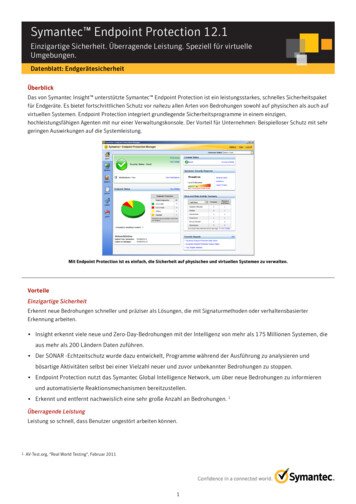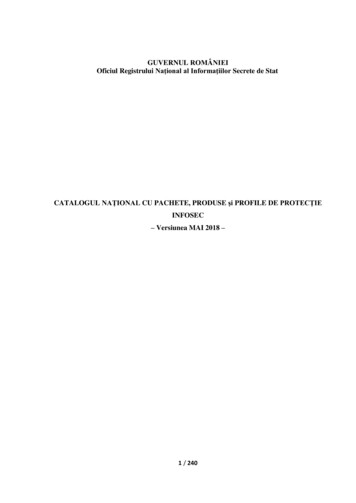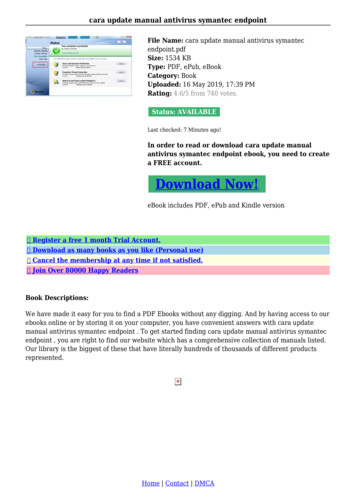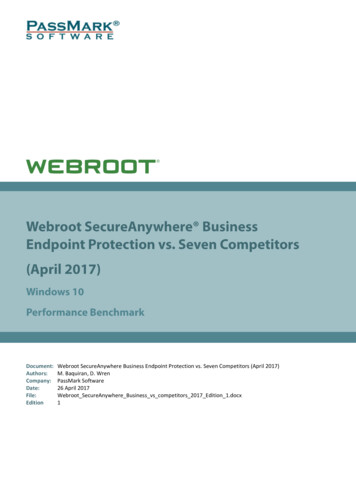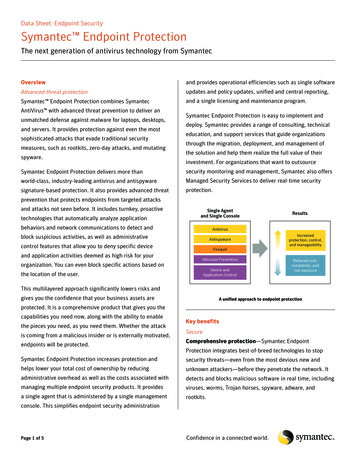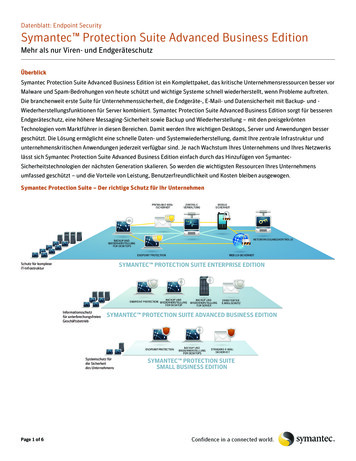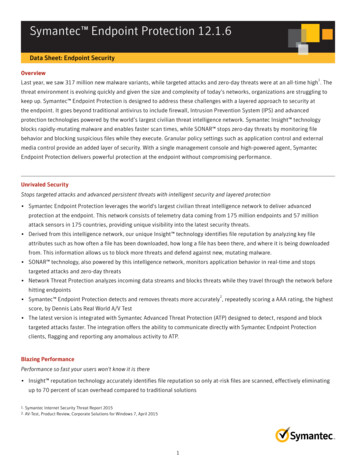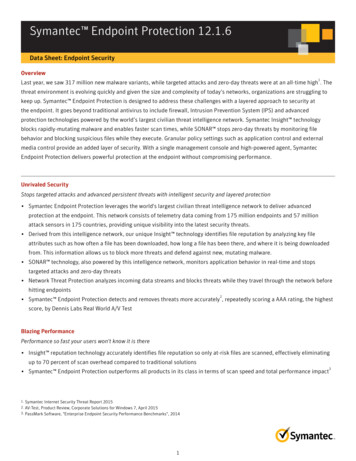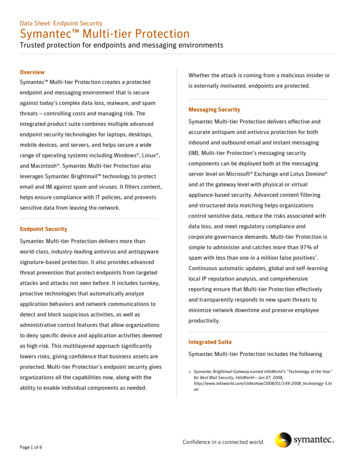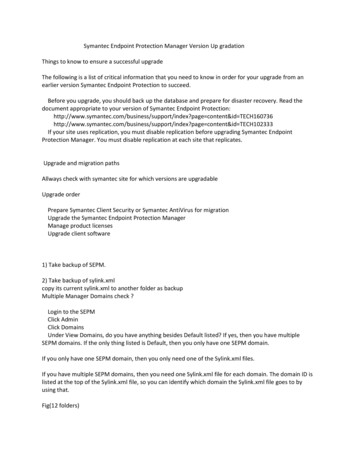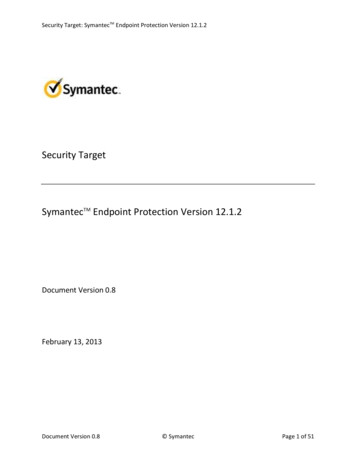
Transcription
Security Target: SymantecTM Endpoint Protection Version 12.1.2Security TargetSymantecTM Endpoint Protection Version 12.1.2Document Version 0.8February 13, 2013Document Version 0.8 SymantecPage 1 of 51
Security Target: SymantecTM Endpoint Protection Version 12.1.2Prepared For:Prepared By:Symantec CorporationApex Assurance Group, LLC350 Ellis Street530 Lytton Avenue, Ste. 200Mountain View, CA 94043Palo Alto, CA 94301www.symantec.comwww.apexassurance.comRevision HistoryVersion Date0.412/22/11DescriptionUpdate in response to ORs of 12/16/11 which included arequest for a revision history.AuthorSue Toorans (Apex)0.51/13/12Respond to ORs filed on behalf of the certifier on 1/6/12Sue Toorans (Apex)0.60.70.83/26/126/20/122/13/13Respond to ORsUpdate due to AGD CR responsesUpdated SEP version to 12.1.2Sue Toorans (Apex)Sue Toorans (Apex)Wes Higaki (Apex)AbstractThis document provides the basis for an evaluation of a specific Target of Evaluation (TOE), the EndpointProtection Version 12.1.2. This Security Target (ST) defines a set of assumptions about the aspects of theenvironment, a list of threats that the product intends to counter, a set of security objectives, a set ofsecurity requirements and the IT security functions provided by the TOE which meet the set ofrequirements.Document Version 0.8 SymantecPage 2 of 51
Security Target: SymantecTM Endpoint Protection Version 12.1.2Table of Contents1Introduction . 51.1ST Reference .51.2TOE Reference .51.3Document Organization .51.4Document Conventions .61.5Document Terminology .61.6TOE Overview .71.7TOE Description .71.7.1 Physical Boundary .71.7.2 Hardware and Software Supplied by the IT Environment .81.7.3 Logical Boundary .102Conformance Claims . 112.1Common Criteria Conformance Claim .112.2Protection Profile Conformance Claim .113Security Problem Definition . 123.1Threats .123.2Organizational Security Policies .133.3Assumptions .134Security Objectives . 154.1Security Objectives for the TOE .154.2Security Objectives for the Operational Environment .154.3Security Objectives Rationale .165Extended Components Definition . 285.1Anti-Virus (FAV) Class of SFRs.285.1.1 FAV ACT (EXT).1 Anti-Virus Actions .285.1.2 FAV ALR (EXT).1 Anti-Virus Alerts .295.1.3 FAV SCN (EXT).1 Anti-Virus Scanning .305.2Extended Security Assurance Components.306Security Requirements . 316.1Security Functional Requirements .316.1.1 Security Audit (FAU) .316.1.2 Antivirus (FAV) – Extended Requirements .346.1.3 Cryptographic Support (FCS).356.1.4 Security Management (FMT) .356.2CC Component Hierarchies and Dependencies .366.3Security Assurance Requirements .376.3.1 Security Assurance Requirements Rationale .386.4Security Requirements Rationale .386.4.1 Security Functional Requirements for the TOE.386.4.2 Security Assurance Requirements .457TOE Summary Specification . 46Document Version 0.8 SymantecPage 3 of 51
Security Target: SymantecTM Endpoint Protection Version 12.1.27.1TOE Security Functions .467.1.1 Antivirus .467.1.2 Audit .467.1.3 Cryptographic Operations .487.1.4 Management .49List of TablesTable 1 – ST Organization and Section Descriptions .5Table 2 – Terms and Acronyms Used in Security Target .7Table 3 – Evaluated Configuration for the TOE .7Table 4 – Logical Boundary Descriptions .10Table 5 – Threats Addressed by the TOE .13Table 6 – Organizational Security Policies .13Table 7 – Assumptions .14Table 8 – TOE Security Objectives .15Table 9 – Operational Environment Security Objectives .16Table 10 – Mapping of Assumptions, Threats, and OSPs to Security Objectives .18Table 11 – Rationale for Mapping of Threats, Policies, and Assumptions to Objectives .27Table 12 – TOE Functional Components .31Table 13 – FAU GEN.1 Events and Additional Information .32Table 14 - TOE SFR Dependency Rationale .37Table 15 – Security Assurance Requirements at EAL2.38Table 16 – Mapping of TOE SFRs to Security Objectives .39Table 17 – Rationale for Mapping of TOE SFRs to Objectives .45Table 18 – Security Assurance Rationale and Measures .45Table 19 – Available Reports .48Table 20 - Cryptographic Module Validations .49Table 21 – Description of Roles Supported in the TOE .50List of FiguresFigure 1 – TOE Boundary .8Document Version 0.8 SymantecPage 4 of 51
Security Target: SymantecTM Endpoint Protection Version 12.1.21 IntroductionThis section identifies the Security Target (ST), Target of Evaluation (TOE), Security Target organization,document conventions, and terminology. It also includes an overview of the evaluated product.1.1 ST ReferenceST TitleSecurity Target: SymantecTM Endpoint Protection Version 12.1.2ST Revision0.6ST Publication DateMarch 26, 2012AuthorApex Assurance Group1.2 TOE ReferenceTOE ReferenceSymantecTM Endpoint Protection Version 12.1.21.3 Document OrganizationThis Security Target follows the following format:SECTIONTITLE1Introduction2Conformance Claims3Security Problem Definition4Security Objectives56Extended ComponentsDefinitionSecurity Requirements7TOE Summary SpecificationDESCRIPTIONProvides an overview of the TOE and defines the hardwareand software that make up the TOE as well as the physicaland logical boundaries of the TOELists evaluation conformance to Common Criteria versions,Protection Profiles, or Packages where applicableSpecifies the threats, assumptions and organizationalsecurity policies that affect the TOEDefines the security objectives for the TOE/operationalenvironment and provides a rationale to demonstrate thatthe security objectives satisfy the threatsDescribes extended components of the evaluation (if any)Contains the functional and assurance requirements for thisTOEIdentifies the IT security functions provided by the TOE andalso identifies the assurance measures targeted to meet theassurance requirements.Table 1 – ST Organization and Section DescriptionsDocument Version 0.8 SymantecPage 5 of 51
Security Target: SymantecTM Endpoint Protection Version 12.1.21.4 Document ConventionsThe notation, formatting, and conventions used in this Security Target are consistent with those used inVersion 3.1 of the Common Criteria. Selected presentation choices are discussed here to aid the SecurityTarget reader. The Common Criteria allows several operations to be performed on functionalrequirements: The allowable operations defined in Part 2 of the Common Criteria are refinement,selection, assignment and iteration. The assignment operation is used to assign a specific value to an unspecified parameter, such asthe length of a password. An assignment operation is indicated by showing the value in squarebrackets and a change in text color, i.e. [assignment value(s)]. The refinement operation is used to add detail to a requirement, and thus further restricts arequirement. Refinement of security requirements is denoted by bold text. Any text removed isindicated with a strikethrough format (Example: TSF). The selection operation is picking one or more items from a list in order to narrow the scope of acomponent element. Selections are denoted by underlined italicized text. Iterated functional and assurance requirements are given unique identifiers by appending to thebase requirement identifier from the Common Criteria an iteration number inside parenthesis,for example, FIA UAU.1.1 (1) and FIA UAU.1.1 (2) refer to separate instances of the FIA UAU.1security functional requirement component.Italicized text is used for both official document titles and text meant to be emphasized more than plaintext.1.5 Document TerminologyThe following table1 describes the terms and acronyms used in this IONU.S. Government Protection Profile Anti-Virus Applications forWorkstations in Basic Robustness Environments, version 1.2, dated 25July 2007Common Criteria version 3.1 (ISO/IEC 15408)Evaluation Assurance LevelFile Transfer ProtocolOrganizational Security PolicySecurity Functional RequirementSecurity Function PolicyStrength Of FunctionSecurity TargetTransmission Control ProtocolDerived from the IDSPPDocument Version 0.8 SymantecPage 6 of 51
Security Target: SymantecTM Endpoint Protection Version 12.1.2TERMDEFINITIONTOETSFTSPTarget Of EvaluationTOE Security FunctionTOE Security PolicyTable 2 – Terms and Acronyms Used in Security Target1.6 TOE OverviewThe Symantec Endpoint Protection Version 12.1.2 delivers a comprehensive antivirus/endpoint securitysolution with a single agent and a single, centralized management console. It has a rules-based firewallengine, browser protection and Generic Exploit Blocking (GE) shields systems from drive-by downloadsand from network based attacks. It protects against viruses, worms, Trojans, spyware, bots, zero-daythreats and root kits.Endpoint Protection Version 12.1.2 may hereafter also be referred to as the TOE in this document.1.7 TOE DescriptionSymantec Endpoint Protection Version 12.1.2 combines Symantec AntiVirus with advanced threatprevention to deliver a defense against malware for laptops, desktops, and servers. It providesprotection against even the most sophisticated attacks that evade traditional security measures, such asrootkits, zero-day attacks, and mutating spyware.The product type of the Target of Evaluation (TOE) described in this Security Target (ST) is an antivirusapplication running on workstations (e.g., desktops and laptops), along with a management componentrunning on a central server to control and monitor execution of the antivirus application.The evaluated features of Symantec Endpoint Protection Version 12.1.2 include the followingcomponents: Symantec Endpoint Protection Client – protects servers, desktops, and laptops systems Symantec Endpoint Protection Manager (and management console) – executes managementoperations1.7.1 Physical BoundaryThe TOE is a software TOE and is defined as the Endpoint Protection Version 12.1.2 and includes theRSAENH cryptographic module from the Microsoft Windows operating systems. In order to comply withthe evaluated configuration, the following hardware and software components should be used:TOE COMPONENTTOE SoftwareIT EnvironmentVERSION/MODEL NUMBEREndpoint Protection Version 12.1.2See Section 1.7.2 – Hardware and Software Supplied by the IT EnvironmentTable 3 – Evaluated Configuration for the TOEDocument Version 0.8 SymantecPage 7 of 51
Security Target: SymantecTM Endpoint Protection Version 12.1.2The TOE boundary is shown below:Figure 1 – TOE BoundaryAt a high level, the TOE interfaces include the following:1. Software interfaces for connection to internal TOE components and external IT products.2. Software interfaces to receive and process traffic from internal TOE components and external ITproducts.3. Management interface to handle administrative actions.The TOE’s evaluated configuration requires one or more instances of a SEP Client, one instance of a SEPManager, and one or more instances of a workstation for management via Console. Communicationsbetween the components are protected via SSL tunnel, provided by the Operational Environment.1.7.2 Hardware and Software Supplied by the IT EnvironmentThe Symantec Endpoint Protection Manager (and management console) system requirements are asfollows:Document Version 0.8 SymantecPage 8 of 51
Security Target: SymantecTM Endpoint Protection Version 12.1.2 32-bit processor: 1-GHz Intel Pentium III or equivalent minimum (Intel Pentium 4 or equivalentrecommended) 64-bit processor: 2-GHz Pentium 4 with x86-64 support or equivalent minimum Intel Itanium IA64 is not supported. Operating systems: Windows XP (32-bit, SP-3 or higher, 64-bit, all SPs), Windows Server 2003(32-bit, 64-bit, R2, SP1 or later), Windows Server 2008 (32-bit, 64-bit). Windows Vista (32-bit, 64-bit) is not officially supported. RAM memory: 1 GB of RAM minimum (2 GB of RAM recommended) Hard disk: 4 GB or more free space Java Runtime Environment 1.6.0.u24 Apache Tomcat 6.0.32 Apache HTTP Server 2.2.16The client system requirements are as follows: 32-bit processor: for Windows operating systems, 1-GHz Intel Pentium III or equivalentminimum (Intel Pentium 4 or equivalent recommended); for Mac operating systems, Intel CoreSolo, Intel Core Duo 64-bit processor: for Windows operating systems, 2-GHz Pentium 4 with x86-64 support orequivalent minimum; for Mac operating systems, Intel Core 2 Duo, Intel Quad-Core Xeon Intel Itanium IA-64 is not supported. PowerPC is not supported (32-bit or 64-bit). Operating systems: Windows XP (32-bit, SP-3 or later, 64-bit, all SPs), Windows XP Embedded(SP-3 or later), Windows Vista (32-bit, 64-bit), Windows 7 (32-bit, 64-bit), Windows 7 Embedded,Windows Server 2003 (32-bit, 64-bit, R2, SP-2 or later), Windows Server 2008 (32-bit, 64-bit),Windows Small Business Server 2011 (64-bit), or Windows Essential Business Server 2008 (64bit), Mac OS X 10.5 or 10.6 (32-bit, 64-bit only), Mac OS X Server 10.5 or 10.6 (32-bit, 64-bit) RAM memory: 512 MB of RAM minimum (1 GB of RAM recommended) Hard disk: 900 MB or more free space Browser: Internet Explorer 7, 8 or 9. Required to install the client by using Remote Push(Windows clients only). Mozilla Firefox 3.6 or 4.0.The Symantec Endpoint Protection Manager includes an embedded database. Alternatively, thefollowing version of Microsoft SQL Server can be used: SQL Server 2008, SP-2 or laterDocument Version 0.8 SymantecPage 9 of 51
Security Target: SymantecTM Endpoint Protection Version 12.1.21.7.3 Logical BoundaryThis section outlines the boundaries of the security functionality of the TOE; the logical boundary of theTOE includes the security functionality described in the following sections.TSFAntivirusAuditCryptographic OperationsManagementDESCRIPTIONThe TOE is designed to help prevent memory-based and file-basedviruses. The TOE can be configured to perform various actions if a virusis detected.The audit services include details on actions taken when a virus isdetected as well as administrative actions performed while accessingthe TOE. The TOE generates audits when security-relevant events occur,stores the audit information on the local system, transmits the auditinformation to a central management system, generates alarms fordesignated events, and provides a means for audit review.Protection of audit data in the audit trail involves the TOE and theOperating System (OS). The TOE controls the insertion of audit eventsinto the audit log and the deletion of audit events from the audit log.The OS provides basic file protection services for the audit log.The TOE implements FIPS-approved cryptographic functionality to verifythe integrity of the signature files download from Symantec SecurityResponse / Live Update.The TOE provides administrators with the capabilities to configure,monitor and manage the TOE to fulfill the Security Objectives. SecurityManagement principles relate to Antivirus and Audit.Table 4 – Logical Boundary DescriptionsDocument Version 0.8 SymantecPage 10 of 51
Security Target: SymantecTM Endpoint Protection Version 12.1.22 Conformance Claims2.1 Common Criteria Conformance ClaimThe TOE is Common Criteria Version 3.1 Revision 3 (July 2009) Part 2 extended and Part 3 conformant atEvaluation Assurance Level 2 augmented with ALC FLR.2.2.2 Protection Profile Conformance ClaimThe TOE claims demonstrable conformance to the U.S. Government Protection Profile Anti-VirusApplications for Workstations in Basic Robustness Environments, version 1.2, dated 25 July 2007.Document Version 0.8 SymantecPage 11 of 51
Security Target: SymantecTM Endpoint Protection Version 12.1.23 Security Problem DefinitionIn order to clarify the nature of the security problem that the TOE is intended to solve, this sectiondescribes the following: Any known or assumed threats to the assets against which specific protection within the TOE orits environment is required.Any organizational security policy statements or rules with which the TOE must comply.Any assumptions about the security aspects of the environment and/or of the manner in whichthe TOE is intended to be used.This chapter identifies assumptions as A.assumption, threats as T.threat and policies as P.policy.3.1 ThreatsThe following are threats identified for the TOE and the IT System the TOE monitors. The TOE itself hasthreats and the TOE is also responsible for addressing threats to the environment in which it resides.The assumed level of expertise of the attacker for all the threats is unsophisticated.The TOE addresses the following threats:THREATDESCRIPTIONT.ACCIDENTAL ADMIN ERROR An administrator may incorrectly install or configure the TOE resultingin ineffective security mechanisms.T.AUDIT COMPROMISEA user or process may gain unauthorized access to the audit trail andcause audit records to be lost or modified, or prevent future auditrecords from being recorded, thus masking a security relevant event.T.AUDFULAn unauthorized user may cause audit records to be lost or preventfuture records from being recorded by taking actions to exhaust auditstorage capacity, thus masking an attacker's actions.T.MASQUERADEA user or process may masquerade as another entity in order to gainunauthorized access to data or TOE resourcesT.POOR DESIGNUnintentional errors in requirements specification or design of the TOEmay occur, leading to flaws that may be exploited by a casuallymischievous user or program.T.POOR IMPLEMENTATIONUnintentional errors in implementation of the TOE design may occur,leading to flaws that may be exploited by a casually mischievous useror program.T.POOR TESTLack of or insufficient tests to demonstrate that all TOE securityfunctions operate correctly (including in a fielded TOE) may result inincorrect TOE behavior being discovered thereby causing potentialsecurity vulnerabilities.Document Version 0.8 SymantecPage 12 of 51
Security Target: SymantecTM Endpoint Protection Version 12.1.2THREATT.RESIDUAL DATADESCRIPTIONA user or process may gain unauthorized access to data throughreallocation of memory used by the TOE to scan files or processadministrator requests.A user or process may cause, through an unsophisticated attack, TSFdata or executable code to be inappropriately accessed (viewed,modified, or deleted)A user may gain unauthorized access to an unattended session.T.TSF COMPROMISET.UNATTENDED SESSIONT.UNIDENTIFIED ACTIONST.VIRUSFailure of the authorized administrator to identify and act uponunauthorized actions may occur.A malicious agent may attempt to introduce a virus onto a workstationvia network traffic or removable media to compromise data on thatworkstation, or use that workstation to attack additional systems.Table 5 – Threats Addressed by the TOE3.2 Organizational Security PoliciesThe following Organizational Security Policies apply to the TOE:POLICYP.ACCESS BANNERP.ACCOUNTABILITYP.CRYPTOGRAPHYP.MANUAL SCANP.ROLESDESCRIPTIONThe system shall display an initial banner describing restrictions of use, legalagreements, or any other appropriate information to which users consent byaccessing the system.The authorized users of the TOE shall be held accountable for their actionswithin the TOE.Only NIST FIPS validated cryptography (methods and implementations) areacceptable for key management (i.e.; generation, access, distribution,destruction, handling, and storage of keys) and cryptographic services (i.e.encryption, decryption, signature, hashing, key exchange, and random numbergeneration services)The authorized users of the workstations shall initiate manual anti-virus scansof removable media (e.g., floppy disks, CDs) introduced into the workstationbefore accessing any data on the removable media.The TOE shall provide an authorized administrator role for secureadministration of the TOE. This role shall be separate and distinct from otherauthorized users.Table 6 – Organizational Security Policies3.3 AssumptionsThis section describes the security aspects of the environment in which the TOE is intended to be used.The TOE is assured to provide effective security measures in a co-operative non-hostile environmentonly if it is installed, managed, and used correctly. The following specific conditions are assumed to existin an environment where the TOE is employed.Document Version 0.8 SymantecPage 13 of 51
Security Target: SymantecTM Endpoint Protection Version 12.1.2ASSUMPTIONDESCRIPTIONThe TOE receives alarms from the IT Environment to signal when audit logsA.AUDIT ALARMare nearing capacity.Administrators will back up audit files and monitor disk usage to ensure auditA.AUDIT BACKUPinformation is not lost.A.DOMAIN SEPARATION The IT environment will provide a separate domain for the TOE’s operation.A.NO BYPASSThe IT environment will ensure the TSF cannot be bypassed.Administrators are non-hostile, appropriately trained, and follow allA.NO EVILadministrative guidance.It is assumed that the appropriate physical security is provided within theA.PHYSICALdomain for the value of the IT assets protected by the TOE and the value ofthe stored, processed, and transmitted information.It is assumed that the IT environment will provide a secure line ofA.SECURE COMMScommunications between distributed portions of the TOE and between theTOE and remote administrators.Administrators will implement secure mechanisms for receiving andA.SECURE UPDATESvalidating updated signature files from the Anti-Virus vendors, and fordistributing the updates to the central management systems.Table 7 – AssumptionsDocument Version 0.8 SymantecPage 14 of 51
Security Target: SymantecTM Endpoint Protection Version 12.1.24 Security Objectives4.1 Security Objectives for the TOEThe IT security objectives for the TOE are addressed below:OBJECTIVEO.ADMIN GUIDANCEDESCRIPTIONThe TOE will provide administrators with the necessaryinformation for secure management.O.ADMIN ROLEThe TOE will provide an authorized administrator role to isolateadministrative actions.O.AUDIT GENERATIONThe TOE will provide the capability to detect and create recordsof security-relevant events.O.AUDIT PROTECTThe TOE will provide the capability to protect audit information.O.AUDIT REVIEWThe TOE will provide the capability to selectively view auditinformation.O.CONFIGURATION IDENTIFICATION The configuration of the TOE is fully identified in a manner thatwill allow implementation errors to be identified.O.CORRECT TSF OPERATIONThe TOE will pr
The evaluated features of Symantec Endpoint Protection Version 12.1.2 include the following components: Symantec Endpoint Protection Client - protects servers, desktops, and laptops systems Symantec Endpoint Protection Manager (and management console) - executes management operations 1.7.1 Physical Boundary
